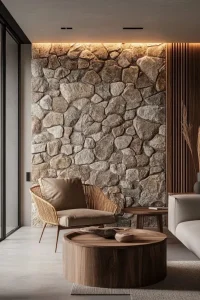Bold Colors and Natural Materials in Contemporary Architecture
Bold Colors: The Vibrant Character of Space
Color is one of the most powerful tools in architectural design. A deep red accent wall, an emerald green sofa, or a navy-blue detail can instantly define a room’s identity. In modern interior design, bold colors are used strategically and sparingly. A single piece of furniture or a small painted surface can inject energy without overwhelming the architecture. These colors bring rhythm, highlight focal points, and give each project its unique personality.
Natural Materials: Honest and Timeless
If bold colors bring intensity, natural materials bring balance and authenticity. Wood adds warmth and texture, exposed concrete expresses honesty and industrial beauty, while stone reflects permanence and timelessness. Architects use these materials in their raw form, without unnecessary coverings, to emphasize honesty in design. Natural materials also connect people emotionally to their environment—reminding us of nature within contemporary spaces.
The Architect’s Role: Where Color Meets Material
Great architecture lies in harmony. The most successful projects are those where color and material complement one another. A concrete ceiling paired with deep red furniture, or a stone wall with a bold emerald accent, creates a dialogue of contrasts. These combinations transform a static space into an experience—one that is not only seen but also felt.
Design Recommendations for Architects and Interior Designers
- Apply bold colors in small, intentional gestures.
- Highlight natural materials in their raw, authentic state.
- Use lighting to emphasize textures and strengthen the color–material contrast.
Conclusion
In contemporary architectural practice, bold colors are the pulse of life, while natural materials are the steady heartbeat of the earth. Together, they form a timeless balance—spaces that are vibrant yet grounded, expressive yet honest. This combination is more than a trend; it is the spirit of contemporary architectural design.




